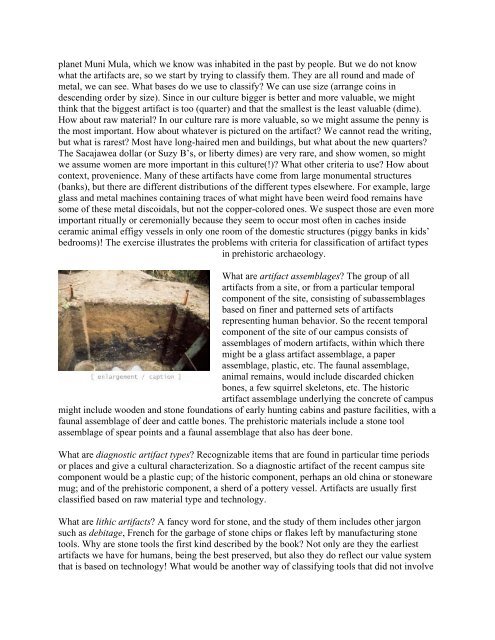INTRODUCTION TO ARCHAEOLOGY Nancy White - Touro Institute
INTRODUCTION TO ARCHAEOLOGY Nancy White - Touro Institute
INTRODUCTION TO ARCHAEOLOGY Nancy White - Touro Institute
You also want an ePaper? Increase the reach of your titles
YUMPU automatically turns print PDFs into web optimized ePapers that Google loves.
planet Muni Mula, which we know was inhabited in the past by people. But we do not know<br />
what the artifacts are, so we start by trying to classify them. They are all round and made of<br />
metal, we can see. What bases do we use to classify? We can use size (arrange coins in<br />
descending order by size). Since in our culture bigger is better and more valuable, we might<br />
think that the biggest artifact is too (quarter) and that the smallest is the least valuable (dime).<br />
How about raw material? In our culture rare is more valuable, so we might assume the penny is<br />
the most important. How about whatever is pictured on the artifact? We cannot read the writing,<br />
but what is rarest? Most have long-haired men and buildings, but what about the new quarters?<br />
The Sacajawea dollar (or Suzy B’s, or liberty dimes) are very rare, and show women, so might<br />
we assume women are more important in this culture(!)? What other criteria to use? How about<br />
context, provenience. Many of these artifacts have come from large monumental structures<br />
(banks), but there are different distributions of the different types elsewhere. For example, large<br />
glass and metal machines containing traces of what might have been weird food remains have<br />
some of these metal discoidals, but not the copper-colored ones. We suspect those are even more<br />
important ritually or ceremonially because they seem to occur most often in caches inside<br />
ceramic animal effigy vessels in only one room of the domestic structures (piggy banks in kids’<br />
bedrooms)! The exercise illustrates the problems with criteria for classification of artifact types<br />
in prehistoric archaeology.<br />
What are artifact assemblages? The group of all<br />
artifacts from a site, or from a particular temporal<br />
component of the site, consisting of subassemblages<br />
based on finer and patterned sets of artifacts<br />
representing human behavior. So the recent temporal<br />
component of the site of our campus consists of<br />
assemblages of modern artifacts, within which there<br />
might be a glass artifact assemblage, a paper<br />
assemblage, plastic, etc. The faunal assemblage,<br />
animal remains, would include discarded chicken<br />
bones, a few squirrel skeletons, etc. The historic<br />
artifact assemblage underlying the concrete of campus<br />
might include wooden and stone foundations of early hunting cabins and pasture facilities, with a<br />
faunal assemblage of deer and cattle bones. The prehistoric materials include a stone tool<br />
assemblage of spear points and a faunal assemblage that also has deer bone.<br />
What are diagnostic artifact types? Recognizable items that are found in particular time periods<br />
or places and give a cultural characterization. So a diagnostic artifact of the recent campus site<br />
component would be a plastic cup; of the historic component, perhaps an old china or stoneware<br />
mug; and of the prehistoric component, a sherd of a pottery vessel. Artifacts are usually first<br />
classified based on raw material type and technology.<br />
What are lithic artifacts? A fancy word for stone, and the study of them includes other jargon<br />
such as debitage, French for the garbage of stone chips or flakes left by manufacturing stone<br />
tools. Why are stone tools the first kind described by the book? Not only are they the earliest<br />
artifacts we have for humans, being the best preserved, but also they do reflect our value system<br />
that is based on technology! What would be another way of classifying tools that did not involve
















